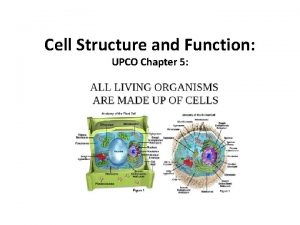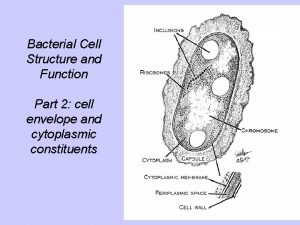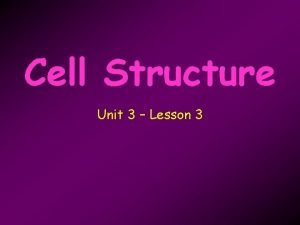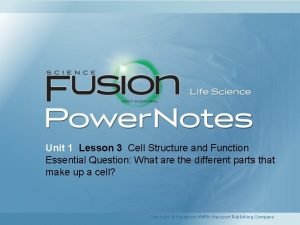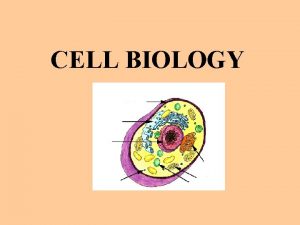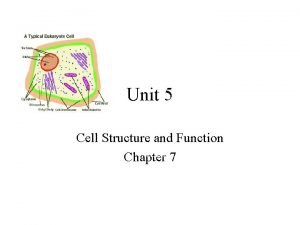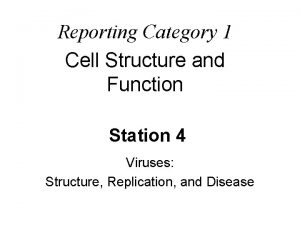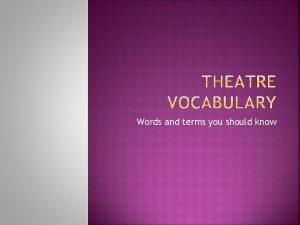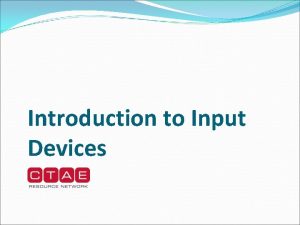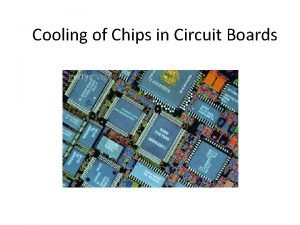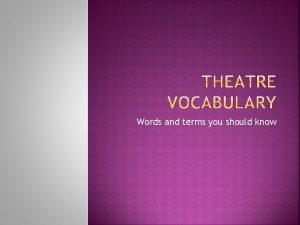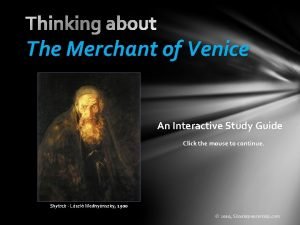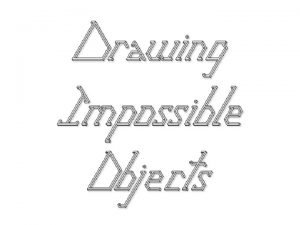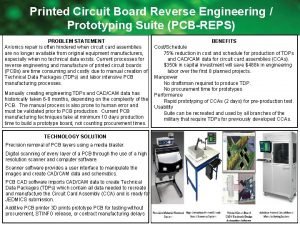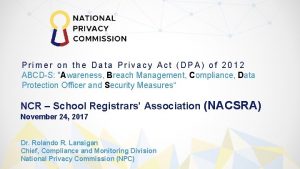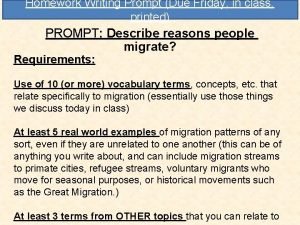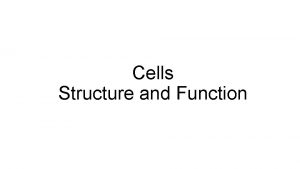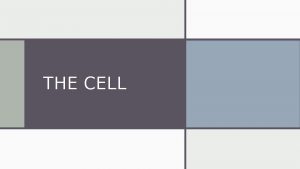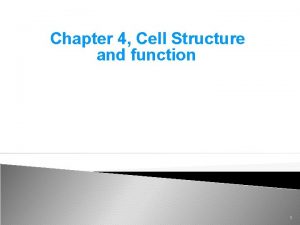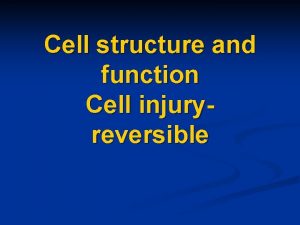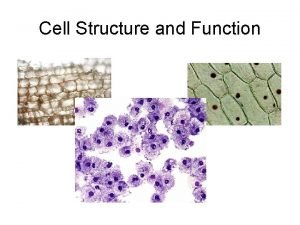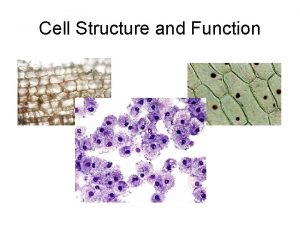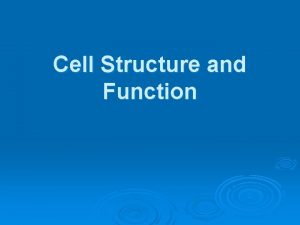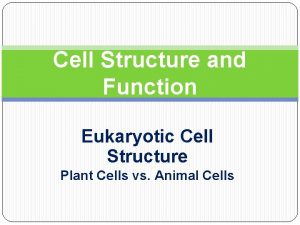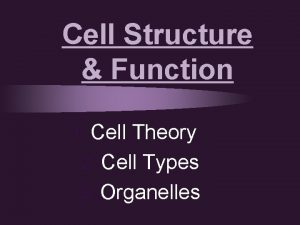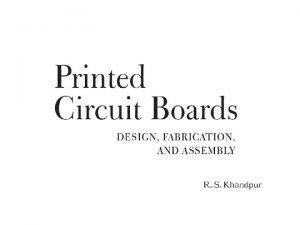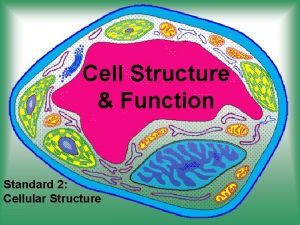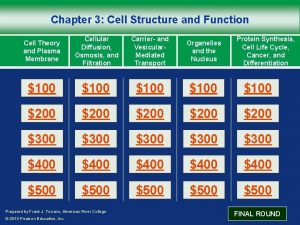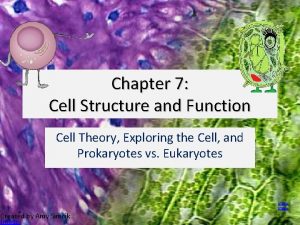Chapter 4 Cell Structure and Function The printed






































- Slides: 38

Chapter 4 - Cell Structure and Function The printed out notes are more detailed than these slides, you are expected to read the chapter and your notes - anything is fair game on the test, but the cell chapter is largely review.

Quick: Grab some scratch paper and quickly discuss with your partner what you remember from freshman biology about the cell.

Early Contributions Hooke – first person to see the cell (cork) Leeuwenhoek – first to see living cells Schleiden – proposed all plants made of cells Schwann – proposed all animals made of cells Virchow

The Cell Theory 1. Every living organism is made of one or more cells. 2. The cell is the basic unit of structure and function. It is the smallest unit that can perform life functions. 3. All cells arise from preexisting cells. *Why is the Cell Theory called a Theory and not a Fact?


Figure 4. 3

Single Cheek Cell - at different illuminations

ALL CELLS HAVE: 1. Cell Membrane a) Phospholipid Bilayer (double layer) b) Proteins c) Carbohydrates

2. Genetic Material 3. Cytoplasm (cytosol) ORGANELLES float within cytoplasm and perform specific functions

Prokaryote vs Eukaryote Cells Endosymbiosis theory: All organelles seem to share many properties with bacteria. Lynn Margulis proposed endosymbiont hypothesis: that organelles derived from ancient colonization of large bacteria (became the eukaryotic cell) by smaller bacteria (became the mitochondria, chloroplast, etc. ) Symbiosis = "living together". *Mitochondria & Chloroplasts have their own DNA Animation at Microbiological Concepts

Prokaryote Cells

Figure 4. 4 a

Eukaryotes

Quick Recap. . . . 1. What are the two main types of cells? 2. Which one is larger? 3. Which one does not have a membrane bound nucleus? 4. What are three main parts of the cell (that all cells have)? 5. What are the 3 components of the cell theory? 6. What theory explains how eukaryotes evolved?

It may seem that in these slides there were quite a few "more on this later. . " notes. . That's because cell biology is a huge area, and is divided into many branches that biologists specialize in. . . 1) Oncology 2) Microbiology 3) Genetics 4) Paleobiology 5) Pathology . . . to name a few Here's an older video that compares prokaryotes and eukaryotes and discusses how cells evolved, film by the Phoenix Learning Group (17 minutes) And a shorter video on the main parts of The Cell

The Parts of the Cell

I am a reticulated python. Ask me what I have to do with the endoplasmic reticulum.

Figure 4. 10 a

The Golgi Apparatus is a Delivery System Proteins are packaged as vesicles and exported from the cell.

Ribosomes - Sites of Protein Synthesis DNA is converted to RNA that leaves the nucleus and instructs the ribosomes what amino acids to make chains of amino acids = a protein Hey! Remember enzymes?

Lysosomes - Intracellular Digestion Centers TAY-SACHS disease – What do lysosomes have to do with this deadly disease? Article and Video on Tay Sachs


Hey. . remember enzymes? The Peroxisome Found in virtually all plant and animal cells, this organelle plays a critical role in normal cell functioning. In human cells, peroxisomes house some sixty enzymes, involved in such metabolic processes as bile acid, cholesterol, and plasmalogen biosynthesis, as well as ßoxidation As a by-product of its normal function, and the reason the organelle is so named, the peroxisome produces hydrogen peroxide. To neutralize this potentially toxic compound, a normally functioning peroxisome imports the hydrogen peroxide-metabolizing enzyme catalase, from the cytosol of the cell. Catalase converts hydrogen peroxide to water and oxygen

What happens if your mitochondria don’t work? Mitochondrial Disease Video Why is mitochondrial disease so devastating to children? Consider the mitochondria have their own DNA separate from the parental DNA. How could you cure this disease?

Focus on Plant Cells

Cytoskeleton How do cells maintain their shape? How do they move? - pseudopod - cilia - flagella

Pseudopod – extensions of the cell that allow for movement (ameba), depend on actin filaments Cilia (hair) & Flagella (whip) --function in movement -- 9+ 2 Arrangement of microtubules

Practice Drawing Plant and Animal Cells

What is this structure?

Mini Quiz 1. What part of the cell produces vesicles for export? 2. What part of the cell makes proteins? 3. What part of the cell produces ATP? 4. What part of the cell transports materials throughout the cytoplasm? 5. What part of the cell has a cis and a trans face?



What is this structure?


Find the: a. Nucleolus b. Centriole c. Vesicle d. Smooth ER e. Lysosome

Figure 4. 7 b

Show, Don't Tell Each person will get a cell concept. For your concept, design a picture that goes with it and a GESTURE for the idea. Be prepared to share your pictures and gestures with the class. Your classmates will use your picture and your gesture to guess what your concept was. It’s like playing a twisted form of charades! You should be able to draw your picture on the fly, on the board, but have a plan in place before you go up there.

Terms / Concepts for Show, Don't Tell cell_theory mitochondria chloroplast prokaryote protein_synthesis eukaryote nucleus lysosome ribosome endoplasmic_reticulum cytoskeleton golgi_apparatus enzyme messenger_RNA chromatin phospholipid_bilayer cilia flagella microscope peroxisome
 Eukaryotic cell structure
Eukaryotic cell structure Chapter 7 cell structure and function section review 7-2
Chapter 7 cell structure and function section review 7-2 Chapter 5 cell structure and function
Chapter 5 cell structure and function What is the function of cell wall in plant cell
What is the function of cell wall in plant cell Chapter 4 cell theory and cell study
Chapter 4 cell theory and cell study Bacterial cell structure and function
Bacterial cell structure and function Lesson 3 cell structure and function answer key
Lesson 3 cell structure and function answer key Cell organelles structures and functions organizer
Cell organelles structures and functions organizer What is the structure and function of the smooth er?
What is the structure and function of the smooth er? Cell
Cell Cell structure graphic organizer
Cell structure graphic organizer Cell structure and function
Cell structure and function Unit 5 cell structure and function answer key
Unit 5 cell structure and function answer key Category 1 cell structure and function
Category 1 cell structure and function Category 1 cell structure and function
Category 1 cell structure and function Category 1 cell structure and function
Category 1 cell structure and function Printed words including dialogue
Printed words including dialogue Types of headlines
Types of headlines Bound printed matter
Bound printed matter Training printed materials
Training printed materials Items with an advertiser's name printed on them
Items with an advertiser's name printed on them It is a printed plan of the plumbing system
It is a printed plan of the plumbing system The northern renaissance begins
The northern renaissance begins Student portfolio examples pdf
Student portfolio examples pdf Introduction to input devices
Introduction to input devices Definetion of computer
Definetion of computer One way to cool chips mounted on the circuit boards
One way to cool chips mounted on the circuit boards Billy wigglestick
Billy wigglestick Printed pages vs web pages
Printed pages vs web pages Shylock
Shylock Impossible triangle
Impossible triangle Circuit board reverse engineering
Circuit board reverse engineering Printed educational materials
Printed educational materials Printed learning materials
Printed learning materials Signature over printed name meaning
Signature over printed name meaning Printed matter
Printed matter Difference between mercury cell and diaphragm cell
Difference between mercury cell and diaphragm cell Prokaryotic reproduction
Prokaryotic reproduction Plant and animal cell venn diagram
Plant and animal cell venn diagram


